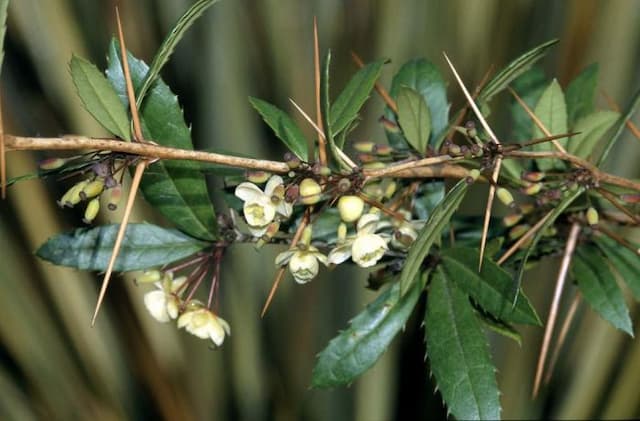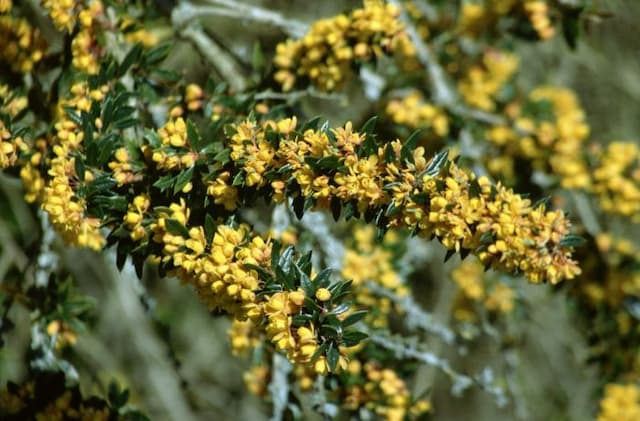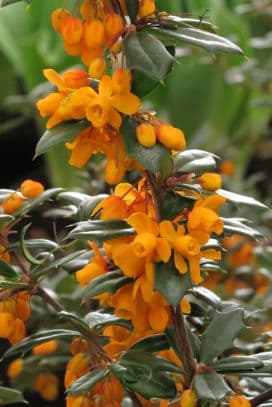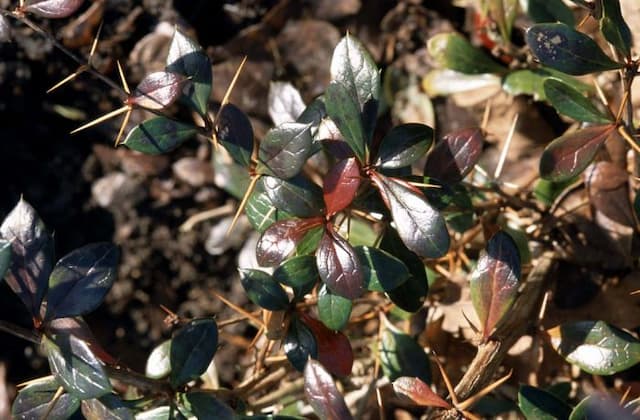Japanese Barberry Berberis 'Goldilocks'

ABOUT
The Berberis 'Goldilocks' is a striking shrub known for its vibrant foliage, which showcases visually compelling hues. The leaves are a bright yellow, adding a splash of luminosity to gardens. These leaves can often turn into a more fiery range of colors, including orange and red hues, as the seasons change, providing dynamic interest throughout different times of the year. The plant produces small flowers that can range from a soft yellow to a subtle red, often appearing in small clusters, enhancing its ornamental appeal. Additionally, small berries can form, which typically bear a red or dark color, providing a striking contrast against the yellow leaves and attracting birds and other wildlife. The overall form of the 'Goldilocks' is dense and bushy, giving it a full appearance with branches that arch gracefully. Its thorny stems make it stand out and can also provide a defensive barrier in landscape designs, while the foliage maintains its appeal from spring through fall.
About this plant
 Names
NamesFamily
Berberidaceae.
Synonyms
Goldilocks Barberry, Golden Barberry.
Common names
Berberis 'Goldilocks'
 Toxicity
ToxicityTo humans
Berberis, commonly known as barberry, is considered mildly toxic to humans. The plant contains alkaloids, such as berberine, which can cause nausea, vomiting, diarrhea, dizziness, fainting, and lethargy if ingested in significant quantities. The severity of the symptoms can vary depending on the amount consumed and the individual's sensitivity. It is advisable to avoid ingesting parts of the barberry plant.
To pets
Barberry is also mildly toxic to pets, including cats and dogs. The presence of alkaloids like berberine can cause similar symptoms as in humans, such as vomiting, diarrhea, lethargy, and potentially depression. If a pet ingests a large amount of barberry, it is recommended to contact a veterinarian to assess the risk and determine if treatment is necessary. To avoid any health issues, it is best to prevent pets from chewing on or ingesting any part of the barberry plant.
 Characteristics
CharacteristicsLife cycle
Perennials
Foliage type
Deciduous
Color of leaves
Mixed
Flower color
Yellow
Height
3 feet (0.91 meters)
Spread
3 feet (0.91 meters)
Plant type
Shrub
Hardiness zones
5
Native area
Asia
Benefits
 General Benefits
General Benefits- Attractive foliage: Berberis Goldilocks offers vibrant, golden-yellow leaves that add a splash of color to any garden.
- Drought tolerant: Once established, this plant is quite resistant to drought, making it suitable for dry climates or water-wise landscapes.
- Low maintenance: It requires minimal care once settled in, which makes it ideal for both novice and experienced gardeners.
- Compact size: Its small stature makes it perfect for use in smaller gardens or as a border plant without overwhelming the space.
- Seasonal interest: Provides year-round interest with its foliage, and in some climates may also provide spring flowers and autumn berries.
- Pest resistant: Naturally resistant to many pests, reducing the need for chemical treatments in the garden.
- Deer resistant: Less likely to be eaten by deer, protecting your garden from unwanted grazing.
 Medical Properties
Medical Properties- This plant is not used for medical purposes
 Air-purifying Qualities
Air-purifying QualitiesThis plant is not specifically known for air purifying qualities.
 Other Uses
Other Uses- Photography Prop: The vibrant yellow foliage of Goldilocks makes it an excellent plant for photographers who want to add a pop of color to outdoor portrait backgrounds.
- Natural Fabric Dyes: The bark and roots of the Goldilocks can be used to create natural dyes for coloring textiles with shades of yellow or orange.
- Artistic Inspiration: Artists may use the striking appearance of the Goldilocks for painting or drawing natural landscapes, capturing its color and form.
- Culinary Garnish: Although not commonly consumed, the bright leaves of the Goldilocks can be used as a decorative garnish for plating in high-end culinary presentations.
- Floral Arrangements: Stems of Goldilocks can be incorporated into floral arrangements to add structure and a contrasting color among other flowers.
- Themed Gardens: Goldilocks can be used in themed garden designs that focus on gold-colored plants or for creating a 'Goldilocks and the Three Bears' fairytale-inspired garden.
- Wildlife Shelter: Dense growth of Goldilocks shrubs can provide shelter and nesting opportunities for small wildlife in the garden.
- Educational Tool: Goldilocks can be used in plant identification courses or workshops, teaching about plant taxonomy and characteristics of the Berberidaceae family.
- Garden Borders: When planted in rows, Goldilocks can serve as a bright, natural border to define different areas within a garden landscape.
- Winter Interest: Goldilocks can retain its leaves during mild winters, offering visual interest in gardens that otherwise become dormant and colorless.
Interesting Facts
 Feng Shui
Feng ShuiBarberry is not used in Feng Shui practice.
 Zodiac Sign Compitability
Zodiac Sign CompitabilityBarberry is not used in astrology practice.
 Plant Symbolism
Plant Symbolism- Protection: Berberis, commonly known as Barberry, often has thorny branches which historically were thought to ward off evil spirits and negative energies. Hence, it symbolizes protection.
- Inner Reflection and Correction: The sharp thorns of the Barberry also represent personal reflection on one's inward misgivings or mistakes, suggesting a period of correction or purification.
- Adaptability: As Barberry plants are hardy and can grow in diverse conditions, they are seen as a symbol of adaptability and perseverance in the face of adversity.
 Water
WaterFor the Japanese Barberry, water it deeply once a week during its growing season in spring and summer, ensuring it receives about 1 to 1.5 inches of water. During the fall and dormant winter months, reduce watering to every two to three weeks depending on the weather conditions. Aim for an even moisture level in the soil, and if using a drip irrigation system, adjust it to dispense approximately 2 gallons per session. Overwatering or allowing the soil to stay soggy can lead to root rot, so ensure the soil is well-draining.
 Light
LightJapanese Barberry prefers full sun to partial shade conditions. It thrives best in a spot that receives at least 6 hours of direct sunlight a day, but it can also tolerate some light shade, especially in the afternoon when the sun is hottest. Avoid deep shade as it may lead to poor foliage color and reduced vigour.
 Temperature
TemperatureThe Japanese Barberry is hardy and can tolerate a wide range of temperatures, surviving minimum temperatures down to around -30°F. The ideal growing temperatures are between 50°F and 75°F. This plant can withstand occasional temperature spikes above this range, but prolonged heat can cause stress, especially if not properly watered.
 Pruning
PruningPrune Japanese Barberry to shape it and remove any dead or damaged branches, ideally in late winter or early spring before new growth starts. It can be pruned again in mid-summer if necessary for size control. Regular pruning helps to encourage a dense growth habit and maintain an attractive appearance but do so carefully due to its thorns.
 Cleaning
CleaningAs needed
 Soil
SoilBarberry 'Goldilocks' thrives best in well-draining soil with a mix of loam, peat, and sand, ensuring it is not waterlogged. An ideal soil pH for Barberry should be slightly acidic to neutral, ranging from 6.0 to 7.5.
 Repotting
RepottingJapanese barberry 'Goldilocks' generally does not need frequent repotting; it should be repotted every 2 to 3 years, or when it has outgrown its current pot.
 Humidity & Misting
Humidity & MistingJapanese barberry 'Goldilocks' tolerates a wide range of humidity levels and does not require any specific humidity adjustments to grow well.
 Suitable locations
Suitable locationsIndoor
Place 'Goldilocks' in bright light and rotate often.
Outdoor
Plant in sun to part-shade; water regularly.
Hardiness zone
4-8 USDA.
 Life cycle
Life cycleThe life cycle of Berberis 'Goldilocks', commonly known as Goldilocks Barberry, begins with seed germination, which occurs when environmental conditions are suitable—typically in damp soil with partial to full sunlight. After germination, the seedling stage follows, where the plant establishes its root system and begins to grow its characteristic yellow-golden leaves. The juvenile phase transitions into the adult phase as the plant matures and develops its thorny stems, with the foliage becoming more profuse and vibrant. During the adult phase, Goldilocks Barberry produces small yellow flowers in the spring, which, if pollinated, develop into small, red berries. These berries can be dispersed by birds or other wildlife, leading to the propagation of new plants. The plant then goes through a period of dormancy in the winter, where it loses its leaves and enters a rest phase before beginning a new growth cycle in the spring.
 Propogation
PropogationPropogation time
Early Spring
The most popular method for propagating a Berberis 'Goldilocks' is through softwood cuttings. This procedure is generally done in late spring to early summer when new growth is still pliable and green. To take a cutting, one selects a healthy shoot and cuts a 4 to 6-inch (about 10 to 15 cm) piece, making the cut just below a node. The lower leaves are removed, and the cut end can be dipped in rooting hormone to encourage root development. Then, the cutting is placed in a well-draining soil mix, ensuring at least one node is below the surface of the soil. The soil should be kept moist but not soggy, and the cuttings should be placed in indirect light. Rooting can take several weeks, after which the new plants can be transplanted to their final location.







![Japanese barberry [Bonanza Gold]](/_next/image?url=https%3A%2F%2Fplants-admin.emdemapps.com%2Fimages%2Fplants%2F%2Fimages%2F604b5385e413f.png&w=640&q=75)

